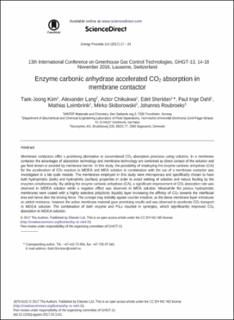| dc.contributor.author | Kim, Taek Joong | |
| dc.contributor.author | Lang, Alexander | |
| dc.contributor.author | Chikukwa, Actor | |
| dc.contributor.author | Sheridan, Edel | |
| dc.contributor.author | Dahl, Paul Inge | |
| dc.contributor.author | Leimbrink, Mathias | |
| dc.contributor.author | Skiborowski, Mirko | |
| dc.contributor.author | Roubroeks, Johannes | |
| dc.date.accessioned | 2020-12-22T13:35:44Z | |
| dc.date.available | 2020-12-22T13:35:44Z | |
| dc.date.created | 2018-01-29T11:06:43Z | |
| dc.date.issued | 2017 | |
| dc.identifier.citation | Energy Procedia. 2017, 114 17-24. | en_US |
| dc.identifier.issn | 1876-6102 | |
| dc.identifier.uri | https://hdl.handle.net/11250/2720816 | |
| dc.description.abstract | Membrane contactors offer a promising alternative to conventional CO2 absorption processes using columns. In a membrane contactor the advantages of absorption technology and membrane technology are combined as direct contact of the solution and gas feed stream is avoided by membrane barrier. In this study, the possibility of employing the enzyme carbonic anhydrase (CA) for the acceleration of CO2 reaction in MDEA and MEA solution in combination with the use of a membrane contactor was investigated in a lab scale module. The membranes employed in this study were microporous and specifically chosen to have both hydrophobic (bulk) and hydrophilic (surface) properties in order to avoid wetting of solution and reduce fouling by the enzymes simultaneously. By adding the enzyme carbonic anhydrase (CA), a significant improvement of CO2 absorption rate was observed in MDEA solution while a negative effect was observed in MEA solution. Meanwhile the porous hydrophobic membranes were coated with a highly selective poly(ionic liquids) layer increasing the affinity of CO2 towards the interfacial area and hence also the driving force. The concept may initially appear counter intuitive, as the dense membrane layer introduces an added resistance, however the active membrane material gave promising results and was observed to accelerate CO2 transport in MDEA solution. The combination of both enzyme and PILs resulted in synergies, which significantly improved CO2 absorption in MDEA solution. | en_US |
| dc.language.iso | eng | en_US |
| dc.publisher | Elsevier | en_US |
| dc.rights | Attribution-NonCommercial-NoDerivatives 4.0 Internasjonal | * |
| dc.rights.uri | http://creativecommons.org/licenses/by-nc-nd/4.0/deed.no | * |
| dc.subject | CO2 | en_US |
| dc.subject | PILs | en_US |
| dc.subject | enzyme | en_US |
| dc.subject | membrane contactor | en_US |
| dc.title | Enzyme Carbonic Anhydrase Accelerated CO2 Absorption in Membrane Contactor | en_US |
| dc.type | Peer reviewed | en_US |
| dc.type | Journal article | en_US |
| dc.description.version | publishedVersion | en_US |
| dc.rights.holder | © 2017 The Authors. Published by Elsevier Ltd. This is an open access article under the CC BY-NC-ND license
(http://creativecommons.org/licenses/by-nc-nd/4.0/). Peer-review under responsibility of the organizing committee of GHGT-13.
doi: 10.1016/j.egypro.2017.03.1141 | en_US |
| dc.source.pagenumber | 17-24 | en_US |
| dc.source.volume | 114 | en_US |
| dc.source.journal | Energy Procedia | en_US |
| dc.identifier.doi | 10.1016/j.egypro.2017.03.1141 | |
| dc.identifier.cristin | 1554224 | |
| cristin.unitcode | 7401,80,0,0 | |
| cristin.unitcode | 7401,80,3,4 | |
| cristin.unitcode | 7401,80,3,1 | |
| cristin.unitname | SINTEF Materialer og kjemi | |
| cristin.unitname | CO2 innfangningsprosesser | |
| cristin.unitname | Nye energiløsninger | |
| cristin.ispublished | true | |
| cristin.fulltext | original | |
| cristin.qualitycode | 1 | |

